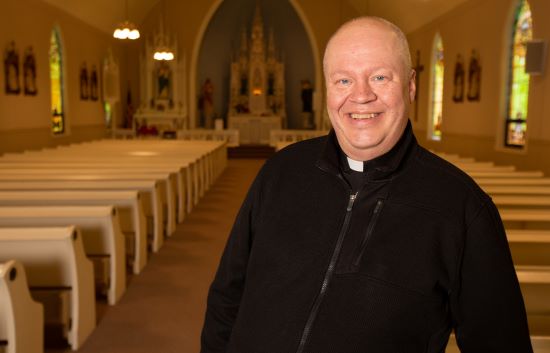
Father Mark Pavlik has been pastor of Mary, Queen of Peace, in Rogers since July 1, 2020. But the parish’s history extends back to the 1850s, well before his tenure.
On Dec. 30, 2002, the former St. Martin of Tours parish merged with nearby St. Walburga to form Mary, Queen of Peace, keeping both a St. Martin campus and a St. Walburga campus. The two churches are about 1.5 miles apart. In 2019, the parish built a “life center” at St. Martin, which provided extra space, with folding chairs and a projector, enabling more people to attend Mass. The parish school also is at St. Martin.
But Masses were held at both sites — St. Walburga on Saturday evening, Sunday morning at St. Martin, weekday Masses were split, which caused some confusion for new parishioners, Father Pavlik said. Materials such as bulletins and faith formation packets were taken to two sites, not extremely time consuming, but time that could be spent for other needs in the growing parish, he said.
“We came to the realization that the splitting between campuses was probably not the best sustainable, long-term plan …,” Father Pavlik said. “When COVID restrictions were lessened, we decided to make a plan for what the future was going to be for our two campuses.”
A long-range planning group, including parish leadership, trustees and “people with a strong history in both campuses,” began meeting in fall 2021 to consider opportunities and challenges for the future. It held open forums and asked for input, Father Pavlik said. Considerations included demographic data projected for the future of the growing community of Rogers, parish finances “and looking forward to the opportunities for our school and parish,” he said.
In the end, the parish council voted unanimously to change St. Walburga’s status from a parish church to an oratory, which is like a church but with more limited or specific use. It was a way to “honor the history and the legacy of St. Walburga and keep it as part of our parish, as active and useful, just not on a weekly basis where the liturgies are split,” Father Pavlik said.
Archbishop Bernard Hebda signed the decree conveying the status of oratory to St. Walburga, noting its designation as a sacred space set aside for divine worship that retains its canonical title and patron. When he approved Father Pavlik’s request, he wrote, “As the term ‘Oratory’ conveys, St. Walburga must remain as a place of prayer. There are no restrictions on the type of sacred celebrations that may be held at Saint Walburga. … Your plan to celebrate the Feast of St. Walburga, as well as funerals, weddings and other liturgical celebrations during the year, is appropriate and seems to be a fitting solution.”
Barb and Jeff Nadeau, parishioners of St. Walburga since 1975, saw their four children receive sacraments and attend CCD classes there. Barb was part of the planning group.
“I think in the end, the committee thought that (an oratory) was a good way of preserving (St. Walburga) …,” Barb said, as preservation takes place amid development and fear the property could be sold.
Barb recalled other churches closing, “and the heartbreak that people go through, and we’ve been fortunate enough to find a way … to develop it into this oratory.”
“There are people who have been going to the church a long time, and that’s why we wanted to … honor the legacy, to say, ‘You know what? It’s still part of our parish,’” Father Pavlik said. “It’s a building we use. We have a cemetery there. We’ve always been part of Mary, Queen of Peace. We’re never going to abandon it.”
ST. WALBURGA HISTORY
Following his ordination May 25, 2013, Father Andrew Stueve celebrated his first Mass at St. Walburga, the same white clapboard church where he made his first Communion, was confirmed and was an altar server for 10 years. Now parochial vicar at St. Charles in Bayport — and a history buff — Father Stueve said the beginnings of St. Walburga go back to 1857, when the first Mass was celebrated in the home of John and Walburga Fehn.
A number of people connected with the early parish had the name Walburga, and some local families have ancestors going back to the early days of the church, Father Stueve said. Many settlers came from Bavaria, Father Stueve said, and he believes St. Walburga “must have been popular among them.”
At some point, Father Stueve believes the Fehns sold about 10 acres adjacent to their farm to the church, where a small log chapel was built in 1858. That chapel stood on the site until 1883, when the current church was completed. “It’s been beautifully kept up,” he said, with the interior painted and new carpeting installed about 15 years ago, but with the original altar, pews, communion railing, stained glass windows and statuary.
Its namesake, St. Walburga, was born in Devonshire, England, in 710, became a nun and in 748 was sent to Germany to help St. Boniface in his missionary work. She later became abbess of two monasteries and died in 779.




